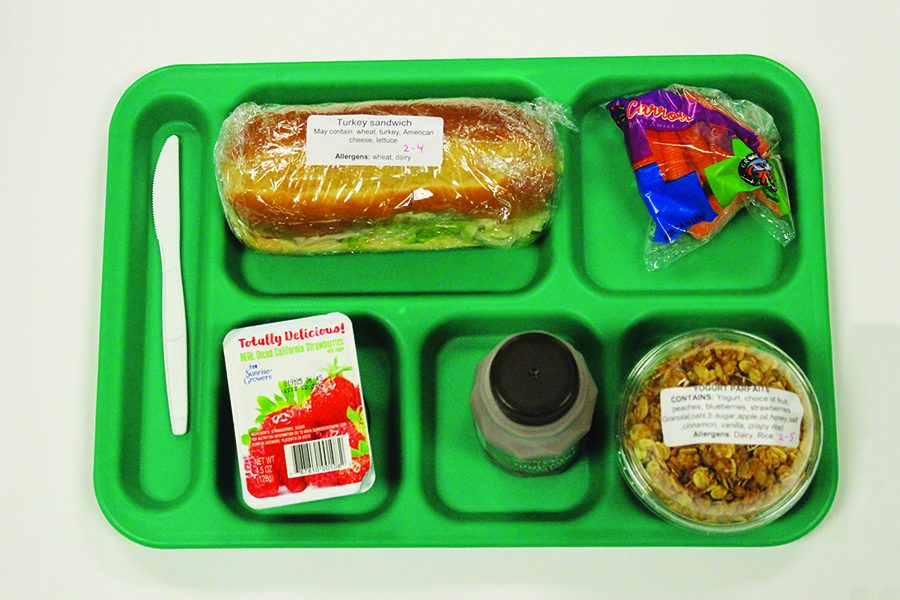Spicing up the school day
WSS goes behind the scenes of the Nutritional Department’s process for choosing the ICCSD lunch menu.
An average WHS lunch.
The room is suffocatingly silent. In an atmosphere tense with nervous energy, faces go pale, resulting from the decision that must be made within the next six weeks. With this decision profoundly affecting the entire school district, one cannot take this matter lightly. Several heated weeks later full of debate and disagreement, there is finally a consensus — crispy chicken strips will indeed be on the lunch menu.
The ICCSD Wellness Committee spends an average of six weeks every summer working on recipe development for the upcoming school year. During this time, the administration must follow federal guidelines mandated by the United States Department of Agriculture (USDA) in order to guarantee that students get a nutritious, well-balanced meal. However, the district does not limit themselves to only looking at healthy options. In addition to healthiness, potential items are assessed on production, transportation and popularity.
“We try to come up with new items, maybe things we have seen in magazines or trade publications,” said Director of Nutrition Services Alison Demory. “We also look at what’s popular in restaurants, because we try to be competitive with what’s out in the real world.”
One of the ways the Wellness Committee incorporates new products is through student tasters. Cindy Smith, the Purchasing & Procurement Specialist in the ICCSD, periodically does taste testing at schools district wide. She, along with schools’ kitchen managers, set up samples in the cafeteria that students provide feedback on.
“[There are] commodity items that we get through the USDA. … From time to time we’ll try asking students to help us sample and give feedback on those,” Demory said. “I don’t ever mind if kids want to taste something if it’s a new menu item or just a menu item they’re not familiar with. … If [students are] unsure, we work with [them] to make sure it’s something they’re going to like.”
The process of selecting students to participate is completely random, according to West Kitchen Manager Julie Peterson. When taste testing days come, it is the first group of students who enter the cafeteria during lunch hours that are chosen to try samples. West has not held taste testing this year due to the adjustment period needed for the new kitchen.
The opinions’ of student tasters play a critical role in determining new menu items. According to Smith, there must be at least a 70 to 80 percent of acceptability of individual products. Yet, these results are often skewed as students may succumb to peer pressure.
“We try to tell people that it doesn’t matter what your friend likes. This is what you would like, what you would eat,” Smith said. “Your friend’s not eating for you. When we put something on the menu we do try to make sure that it is a majority rule.”
Besides planning menus and preparing meals, the nutritional staff’s greatest responsibility is the well-being of the student body. According to Demory, one way the committee aspires to achieve this is through being good role models and educating on student health by setting examples of what healthy, balanced meals look like. Demory believes this lesson is important because nutritious food allows the body to feel well enough to perform at high levels.
“The goal is very simple: we want to feed kids,” Demory said. “Students learn better when they have a full stomach. … We need to fuel your mind as well as your body, so our part is to fuel your body so you can learn and fuel your mind.”
Part of ensuring student well-being is through destigmatizing free and reduced-price meals. One strategy utilized is the enactment of grab-and-go breakfasts to reduce the stereotype that all students who eat breakfast at school are free and reduced students. Furthermore, the ICCSD does not discuss the status of students pertaining to free and reduced-priced meals.
“[Privacy] is very important. … It’s a family issue and we’re not allowed to ever even bring that up,” Peterson said. “I can come in [my office] and I can talk to a student privately if I see that their lunch account is going negative, … [but] it’s a subject that is not talked about on the floor.”
Regardless of how many free and reduced students are enrolled, every school in the district has a breakfast program. Due to City High’s cafeteria being in the basement, the district implemented the grab-and-go system there, meaning they installed a kiosk at the front entrance for students to quickly grab items off of the food cart. On the other hand, because West’s cafeteria is already located near the front entrance and there is not a crowding issue, the grab-and-go system has not yet been used. Instead, breakfast works in the same fashion as lunch, where students go through meal lines and purchase items.
“There are just as many paying-full-price kids eating meals as free and reduced. It’s very even,” Peterson said. “[The free and reduced program] is very important for families that do not have the money for lunch and have to save that money for bills. … It’s there to help people who need the help.”
Not only does the district strive to guarantee that students from a wide range of economic status are able to have a nutritious meal, but they also provide for students with dietary constrictions. According to Demory, students with diet modifications are required to fill out a form on the district website and get a slip from their doctor that is given to the school nurse. Nutritional services will then order substitutes that students with restrictions are able to eat.
“We have several kids who are gluten free, and we order gluten free meals for them,” Peterson said. “There’s alway something to help [students with constrictions] hit the food groups. We have lots of variety and different things to offer.”
According to Peterson, for the past two years, the district has invested in a resource called MealViewer that tells students about their allergy menu. This nutritional menu can be downloaded on mobile devices and provides all nutritional information for the ICCSD’s lunch menu, as well as pricing mandated by the federal government.
There are many different aspects and planning that goes into nutritional services. While taste testing, recipe development and destigmatizing free and reduced-priced lunches are only a small portion of the job, they are very important, according to Smith. The nutrition department does not only provide lunch, they play a vital role in the everyday lives of students as well, and department members take pride in the positive impact their jobs have within the district.
“For me, it was important to have a job where I felt like I made a difference,” Demory said. “I remember my husband saying to me that I had an opportunity to essentially affect every student in the Iowa City area, which seemed like a pretty awesome opportunity to have that ability to help that many children in one community.”
Your donation will support the student journalists of West High School. Your contribution will allow us to purchase Scholarship Yearbooks, newsroom equipment and cover our annual website hosting costs.

Anna Brown is a senior at West High. This is her second year on staff and she is the Co-Copy Editor for print. When she isn't working on WSS, Anna enjoys...

This is Allie's third and final year on staff. This is her second year being the Social Media Editor. When Allie is not doing newspaper she enjoys doing...



